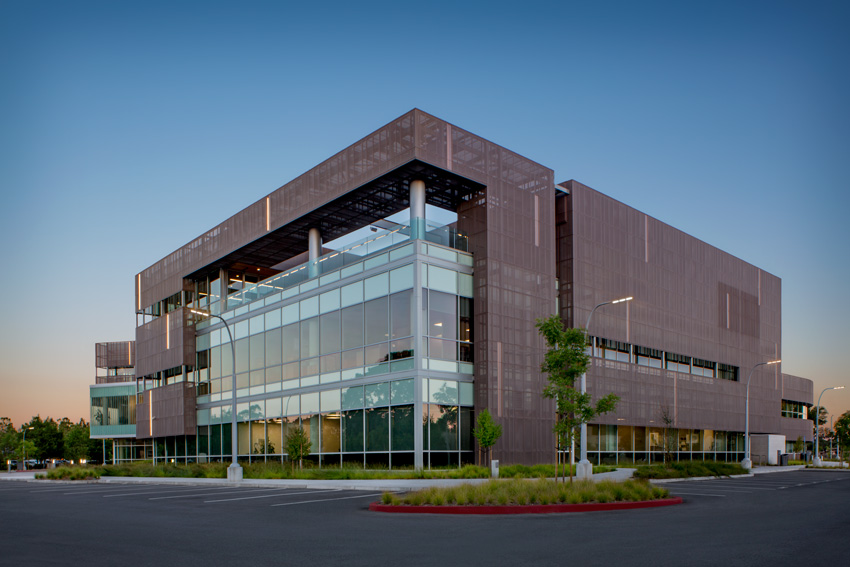This CE Center article is no longer eligible for receiving credits.
A Special Note on Combustibility
Fire has become a bigger concern for today’s buildings. New fire codes and standards are being strictly enforced in more and more areas.
Virtually every building, process, service, design, and installation is affected by the National Fire Protection Association’s (NFPA’s) codes and standards. NFPA standards reflect changing industry needs and evolving technologies, supported by research and development, and practical experience.
For exterior assemblies, like metal panels, NFPA 285: Standard Fire Test Method for Evaluation of Fire Propagation Characteristics of Exterior Wall Assemblies Containing Combustible Components is the governing regulation. This standard provides a test method for determining the fire propagation characteristics of exterior wall assemblies and panels used as components of curtain-wall assemblies that are constructed using combustible materials or that incorporate combustible components.
NFPA 285 is used to evaluate the fire propagation characteristics of exterior wall assemblies and panels used as components of curtain-wall assemblies, as specified in the following: first, the ability of the wall assembly to resist flame propagation over the exterior face of the wall assembly; second, the ability of the wall assembly to resist vertical flame propagation within the combustible components from one story to the next; third, the ability of the wall assembly to resist vertical flame propagation over the interior surface of the wall assembly from one story to the next; and fourth, the ability of the wall assembly to resist lateral flame propagation from the compartment of fire origin to adjacent compartments or spaces.
Meeting Codes with Single-Skin Metal Panels
Single-skin metal panels offer distinct advantages for buildings looking to satisfy multiple code requirements. Single-skin metal panels are carefully manufactured, created without ACM, MCM, or any composite materials. This makes the panels noncombustible, unlike plastic-cored products, and NFPA 285 compliant. Certain manufacturers’ single-skin metal panels are fully tested to exceed ASTM standards and the latest AAMA 508-07 for pressure-equalized rainscreens. The interlocking panel design makes installation quick and easy; it also means no hidden sealants or tapes are used to pass testing certification. Certain single-skin metal panels, such as panels with an aluminum plate thickness of 0.080 inch, satisfy the test methods and performance requirements of Florida Building Code and Miami-Dade County test protocols.
DIGGING DEEPER: THE ENVIRONMENTAL PROFILE OF SINGLE-SKIN METAL PANELS
Single-skin metal panels provide both a natural and highly customizable solution for the design professional. With diverse aesthetics, design capabilities, and performance opportunities, they bolster a building’s performance, visual appeal, and life cycle. Yet having both form and function falls slightly short of the high bar set for modern materials. The best material must also be sustainable and environmentally appropriate.
Single-skin metal panels answer the need for sustainability—naturally. Metal is a 100 percent natural and recyclable product. Often, panels are manufactured from recycled and repurposed metal. Panels are produced quickly with highly automated equipment, avoiding unnecessary energy costs. No plastic is involved in the production of single-skin metal panels, saving dramatically on fossil fuels.
Leading manufacturers produce panels domestically and purchase metal from domestic mills, which saves transportation energy costs. Certain single-skin metal panel systems use no silicone sealants, joint sealants, or gaskets, which are made with petroleum. This offers further savings of fossil fuels and on future maintenance costs. Certain manufacturers offer finish systems that produce no VOCs. Kynar paint providers are environmentally conscious finishers. They use a 100 percent air capture system and destroy the VOCs with a regenerative thermal oxidizer so there is no adverse environmental impact.
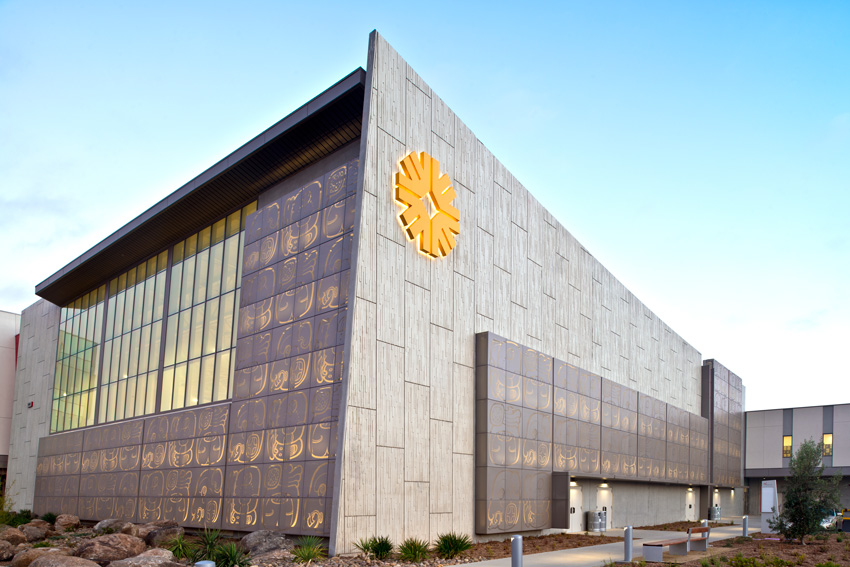
Photo courtesy Dri-Design, Inc.
The Wellness & Aquatic Center at Southwestern College in Chula Vista, California, features a dramatic application of single-skin metal panels incorporating various colors and image technology.
WHERE FORM AND FUNCTION MEET: SINGLE-SKIN METAL PANELS
Today’s innovations in single-skin panels are designed to overcome shortfalls in older methods of exterior metal panel systems, including delamination, staining due to the effects of weather on joint sealants and gaskets, rising costs of production, inefficient installation practices, and a general lack of color, texture, and design options.
Using a natural material with simple design and having new objectives about the way a system could perform, both at the time of installation and for decades later, gave birth to leading single-skin metal panel technology. That vision results in a material fully meeting both form and functional requirements: a highly customizable, 100 percent recyclable, pressure-equalized rainscreen, architectural metal wall system that attaches to nearly any substrate without the use of clips or extrusions, manufactured efficiently and designed to install faster than any comparable product, saving time and money. Leading single-skin metal panels are designed to pass the most stringent air, water, and structural testing requirements in the industry, including the AAMA 508-07 test for pressure-equalized rainscreens as well as Miami-Dade County hurricane testing.
Amanda Voss, MPP, is an author, editor, and policy analyst writing for multiple industry publications and teaching live continuing education courses.
Budget. Use and occupancy. Environmental certifications. Life-cycle costs. Maintenance. Durability. Sustainability. Aesthetics. The list of factors impacting a design professional’s decision-making for each project is overwhelming. The construction and design markets have responded to this need with a wider and deeper array of products, yet the increasingly complex specifications and diverse performance criteria for each product can potentially hinder, rather than help, material selection.
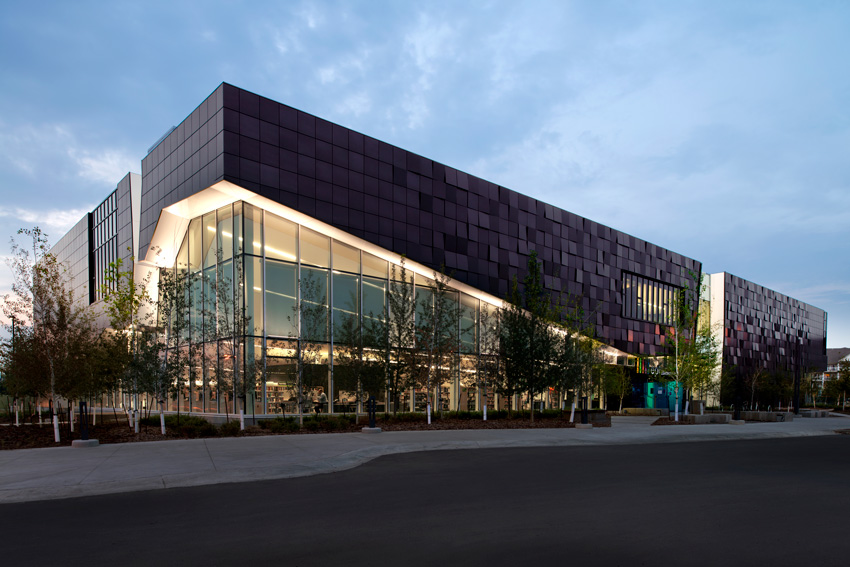
Photo courtesy Dri-Design, Inc.
Modern buildings demand a material that performs well while also looking clean and contemporary.
Metal, with its unique attributes, offers both a natural and highly customizable solution for the design professional. When crafted into single-skin metal panels, metal offers a 100 percent recyclable, pressure-equalized rainscreen, architectural metal wall system that attaches to nearly any substrate without the use of clips or extrusions. Made from a single solid piece of metal, single-skin metal panels are noncombustible. Since the panels are not laminated, or of a composite material, panels will never delaminate. Further reducing maintenance, single-skin metal panels do not require joint sealants, gaskets, or butyl tape, and therefore eliminate the staining and maintenance associated with those systems. Single-skin metal panels are manufactured efficiently and install faster than comparable products, saving time and money.
Today’s materials must also perform. Leading manufacturers’ single-skin metal panels pass the most stringent air, water, and structural testing requirements in the industry, including the American Architectural Manufacturers Association (AAMA) 508-07 test for pressure-equalized rainscreens, as well as Miami-Dade County hurricane testing.
As a building material, metal offers a perfect intersection for form and function. To ensure a best fit for each project, however, understanding specifications, testing, and requirements is vital.
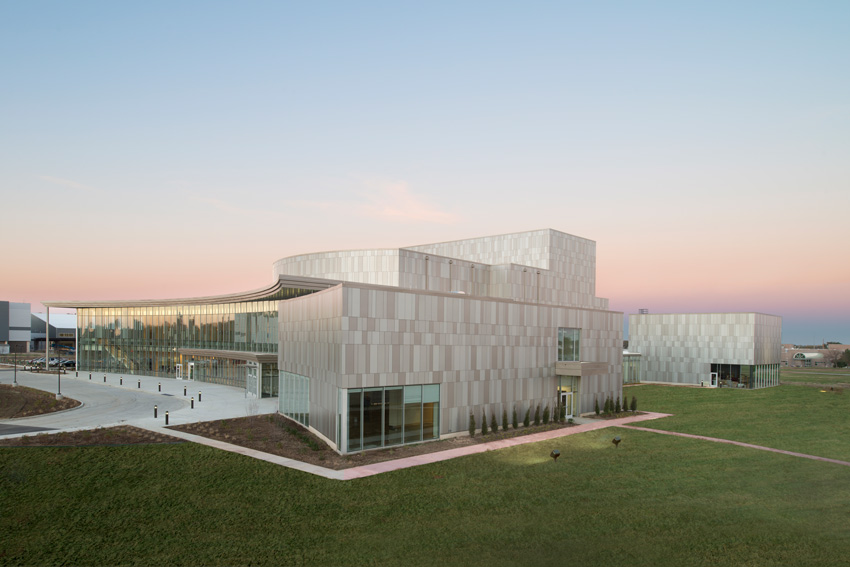
Photo courtesy Dri-Design, Inc.
The Bicknell Family Center for the Arts at Pittsburg State University showcases the aesthetic appeal of single-skin metal panels.
DEFINING THE USE OF METAL IN EXTERIOR APPLICATIONS
The first substantial application of metal cladding occurred on the Crystal Palace of London in 1851. Then, beginning in 1930, aluminum began to be used more frequently as cladding. One of the earliest examples was an aluminum cladding installation on the Federal Reserve Building in Pittsburgh.
The single-skin metal panel system is one of many options for exterior metal systems in wall assembly principles, panel types, materials, and finishes.
Non-Single-Skin Metal Wall Panel Systems
Beyond single-skin metal panels, there are various metal wall panel types. The most common types in use today include metal composite material (MCM) panels, honeycomb core panels, and insulated metal panels (IMPs).
MCM Panels
MCM panel sheets are manufactured using two metal sheets, which most often sandwich a core of either extruded thermoplastic or polyethylene, although some manufacturers may use other core alternatives. The most common type of MCM is the aluminum composite material (ACM), commonly available in 4-millimeter and 6-millimeter thicknesses.
It is important to understand that the MCM manufacturers do not fabricate panels. Rather, they sell sheets of material to many different fabricators and metal shops. Panels are formed from MCM sheets with a variety of installation details, including both wet and dry joints. Due to the diversity in manufacturing and fabricating, some of the fabricated systems have been tested to industry standards, while many have not.
Advantages of MCM panels include the large sheet sizes, which enable creation of large panels measuring 20 feet in length or more. The MCM fabrication process minimizes oil canning in large panels when fabricated properly. Also, MCM material can be curved in many applications.
That said, there are several disadvantages with an MCM system. Since the material is laminated, there is potential for delamination and failure of the material. Installation can be labor intensive due to the more complicated systems involving many pieces and parts. Recycling is more difficult with MCM panels than for single-skin systems. Furthermore, MCM panels can have a significant environmental footprint. MCM panels made with LLDPE and LDPE plastics use the fossil fuel equivalent of manufacturing well over 100,000 plastic bottles to create the plastic core in 10,000 square feet of MCM.
Honeycomb Core Panels
The honeycomb core panel sheets consist of metal skins that are laminated to aluminum, kraft paper, or plastic honeycomb core material. Many panels use coil-coated aluminum skins, which can vary in material thickness. Typical panel thicknesses range from 1⁄4 inch to 3 inches.
Honeycomb core panels offer the design professional certain advantages. As with MCM fabrication, large sheet sizes are available to make large panels measuring 20 feet or greater in length. The honeycomb core panel fabrication process also minimizes oil canning in larger panels when fabricated properly.
Disadvantages to the product include the potential for delamination and failure of the material since it is a composite system. Installation of honeycomb core panels can also be labor intensive because the system involves many pieces and parts. Given the combination of products within the system, recycling of the panels is more difficult than for single-skin systems.
IMPs
IMPs consist of rigid or injectable foam sandwiched between two sheets of metal. IMPs are most commonly found as part of a barrier wall assembly. IMPs can also act as a backup system for other architectural finishes, such as masonry, terra cotta, and architectural metal panels.
IMPs, as a system, have certain advantages. The insulation in the panels contributes to the R-Value of the wall assembly. The panels can act as their own weather barrier.
Disadvantages of IMPs can include the expense of production, as compared to single-skin panels. Furthermore, IMPs can be industrial looking and may not offer much flexibility in color and/or design.
Single-Skin Metal Panels
Single-skin metal panels do not have any laminated layers or core material. They are comprised of a single skin, or sheet, of metal. Panels can be created either via rollformed panels produced from metal coil; by using press-broken profile panels made from sheet metal; or through cassette or plate panels formed from sheet metal, which can offer more sophistication within the structure. Systems can employ either a concealed or exposed fastener system.
Single-skin metal panels offer several advantages. Due to their composition, they avoid delamination. Single-skin systems are easier to install and can be more cost-effective than composite systems. Additionally, single-skin panels offer a wider variety of metals and finishes.
The disadvantage of single-skin panels is its size limitation. Without a laminated core material, panel sizes cannot be made as large as composites due to the possibility of face deflection.
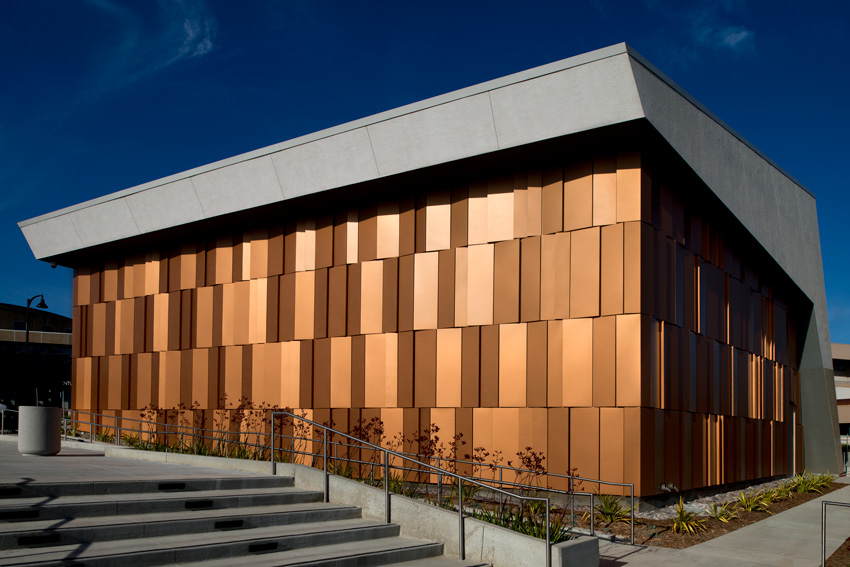
Photo courtesy Dri-Design, Inc.
The Applied Science Center at Ventura College in Ventura, California, uses tapered single-skin metal panels in charcoal, classic copper, and silver color finishes to create visual interest and highlight the angles of the exterior installation.
DIGGING DEEPER: SINGLE-SKIN AESTHETICS
Because they are created from metal, single-skin panels are available in variety of architectural metal options, including steel, aluminum, zinc, copper, titanium, stainless steel, and weathering steel. The most commonly specified architectural metals include steel, aluminum, zinc, and copper. Other, less commonly specified metals include titanium, stainless steel, and weathering steel.
Steel is the least expensive of architectural metals. When single-skin metal panels are specified as steel, the steel used is typically either aluminized, like Galvalume, or galvanized. G90 is the most popular galvanized type. It is commonly finished through the process of coating while in coil form, using paints containing Kynar or similar resins. Commonly available gauges for exterior steel metal panels are 18 (1.19 millimeters), 20 (0.91 millimeter), 22 (0.76 millimeter), and 24 (0.60 millimeter). The lower the gauge number, the thicker and stronger the steel material will be.
Aluminum, the first metal widely used on exteriors, remains a popular choice today. Aluminum offers added corrosive protection over steel. Aluminum is typically coated (painted) or anodized. Mill-finished aluminum in architectural applications is rare because of natural oxidation. For projects concerned with environmental status and certification, design professionals need to check aluminum sourcing.
Zinc is a natural metal alloy that develops a protective patina. Typically available in mill finish (shiny) as well as pre-weathered gray or black, technological advances mean today’s zinc offers some color options by using pigment infused in a clear coat. The zinc surface is self-healing and offers excellent maintenance characteristics. Zinc has definite environmental benefits: a low amount of energy is needed to produce the raw material, and it has high amounts of recycled content. There also is limited runoff from zinc panels. Any runoff that does occur is nonstaining and becomes immediately non-bioavailable (unable to be absorbed and used by the body) upon contact with soil.
Copper, the last of the most popular metal choices for single-skin metal panels, is a natural metal that develops a patina. It is available in both mill finish (shiny) as well as pre-patinated. The thickness is measured by ounce; 24, 32, and 48 ounces are common gauges for architectural panels. Copper has similar long life expectancies to zinc. However, water runoff from copper panels can stain adjacent materials. This material is also expensive, costing approximately twice the amount of zinc.
Besides the array of natural metal choices, single-skin metal panels are available in a variety of finishes: PVDF coatings, FEVE coatings, and anodizing aluminum. Steel and aluminum typically require finishing for longevity of the material in exterior applications as well as to achieve the desired appearance.
PVDF, short for polyvinylidene fluoride, is a resin used in architectural paints. The paints come in both liquid and powder form. This finish offers a wide variety of color options. PVDF finishes are widely used and offer excellent ultraviolet (UV) resistance.
FEVE stands for fluoroethylene and vinyl ether and is a style of paint. Fluorinated segments protect the vinyl ether segments from degradation by UV light and chemicals, while the vinyl ether segments impart solubility, gloss, pigment compatibility, adhesion, and reactivity. FEVE can also be used in unique printing techniques to create realistic faux finishes and intricate designs on metals.
Anodizing is the process of electrochemically controlling, accelerating, and enhancing oxidation of an aluminum substrate. The process produces a uniform oxide that becomes an integral part of the metal and protects the rest of the aluminum substrate from deterioration. Anodizing creates a durable, abrasion-resistant finish and resists effects of temperature, corrosion, humidity, and warping. It has a long life cycle, is 100 percent recyclable, and poses no health risks.
The electrolytic two-step anodizing process takes place in a tank that contains a solution of sulfuric acid and water. The tank is charged with electrical current, and aluminum oxide is formed on the surface of the aluminum. This produces a clear or silver finish. The material can then be immersed in a coloring tank. In the coloring tank, the anodized aluminum is immersed in a bath containing an inorganic metal.
The Aluminum Association has created specific designations dividing anodizing finishes into Architectural Class I and Class II Anodic Coatings. A Class I coating has a mil thickness of 0.7 (18 microns) or greater and is most suitable for exterior applications. A Class II coating, with a minimum mil thickness of 0.4 (10 microns), is best for interior applications and light exterior exposures.
Copper anodizing offers the opportunity to simulate the look of true copper, providing the look of copper penny tones while avoiding the disadvantages of natural copper. The process uses real copper to achieve the color, but the finish will not patina over time. It does not require a clear coat or ongoing treatment to maintain color. The material can be designed for use adjacent to other aluminum materials without galvanic corrosion risk. It also will not leave copper runoff stains on the building’s exterior. Since it is applied to aluminum, it is less than half the weight of real copper.
The single-skin metal panel system provides nearly endless design possibilities, with an unlimited palette of colors, finishes, materials, textures, and custom perforations, including imaging. Nevertheless, a material must do more than meet aesthetic challenges. It must combine beautiful design with new objectives about the way a system can perform, both at the time of installation and for decades later.
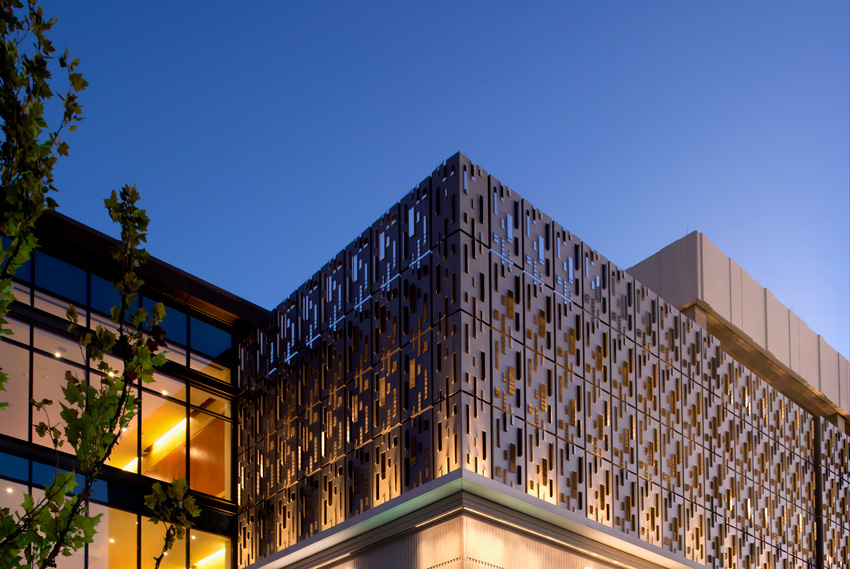
Photo courtesy Dri-Design, Inc.
The Shops at Clearfork in Fort Worth, Texas, demonstrate perforated single-skin metal panels with an anodized finish.
DIGGING DEEPER: SINGLE-SKIN METAL PANEL PERFORMANCE
Performance and Sustainability at the Exterior
To be sustainable, buildings must be able to withstand the trials of climate, seasonal change, and hazardous weather events. Preventing moisture intrusion is a critical requirement for a building envelope’s exterior layers. The envelope must also successfully address the wear and tear from air and thermal conditions over time. When dealing with defense mechanisms against water leakage, architects must pay heed to Murphy’s Law: “If anything can go wrong, it will.” Nothing is more aggravating to a client, short of a total building collapse or the burning of a structure, than the occurrence of a leak.
Proven exterior wall system approaches that successfully control moisture, air, and thermal conductance fall into two categories: conventional wall systems and rainscreen wall systems.
Conventional wall systems can further be divided into single-line barrier walls and secondary gutter backups. Rainscreen wall systems are designed either as drained/back-ventilated systems or as pressure-equalized/compartmentalized systems.
Under conventional strategies, single-line barrier walls, also referred to as barrier walls and face-sealed walls, act as an all-in-one layer to keep out rain, as well as retain conditioned interior air and resist the forces of wind and air pressure. This type of wall can additionally act as a vapor barrier. Examples of single-line barrier walls include EIFS, stucco, and some insulated metal panel systems.
The moisture control of these types of systems is completely reliant on the performance of joint sealants, which may be butyl, gaskets, or silicone sealants. Frequently, these joints use a wet joint, which is a surface-sealed system using a wet joint that is labeled to act as a rainscreen and, in reality, acts as a barrier wall. Consequently, since single-line barrier systems rely on seal integrity at joints, so the workmanship at these joints is critical for long-term performance. Additionally, wet joint systems sealant materials remain tacky, making them susceptible to airborne dirt collection at the joints. When it rains, this accumulated dirt and debris streaks and can potentially stain the exterior finish.
Secondary gutter backup is the other category of a conventional wall system approach. To achieve this approach, a secondary drainage system is added behind the primary system and made integral with the single-line barrier skin. Examples include aluminum and glass curtain-wall systems. This system is highly dependent on the integrity of internal seals and workmanship of installation.
Rainscreen wall systems take a different approach to the exterior wall and building envelope.
The Rainscreen Principle was first defined in the 1988 book Rainscreen Cladding: A Guide to Design Principles and Practices by JM Anderson and JR Gill. The Rainscreen Principle is based on two distinct barriers or leaves: the outer leaf and inner leaf. The outer leaf sheds and controls water but may not necessarily eliminate the majority of the rainwater. The inner leaf has multiple functions, including acting as the final moisture barrier, the air/vapor barrier, providing insulation, and serving as the building’s structural wall.
Two distinct approaches to weather protection in rainscreens have emerged. The drained and back-ventilated rainscreen strategy involves draining off most of the rainwater at the outermost surface of the wall and providing for cavity drainage and evaporation for the remainder.
Elements of the drained and back-ventilated rainscreen include:
- Cladding (sheets, panels, or planks) is fixed to support channels or rails as the outermost exposed leaf or barrier.
- Joints in the outer leaf are open but designed to minimize (not prevent) water penetration by kinetic force.
- Water is permitted to run down the interior face of the outer leaf cladding.
- A cavity (or minimum allowable width of air space) between the outer leaf and inner leaf is necessary to facilitate positive back-ventilation.
- An air/water barrier at the rear of the cavity (outer face of inner leaf) is required.
- The inner leaf must be completely flashed.
Since drained and back-ventilated rainscreen systems are not pressure equalized, the exterior leaf must be designed to withstand 100 percent of the building’s wind load. Examples of outer leaf cladding include metal, stone, wood, and terra cotta.
Single-Skin Metal Panels as a Rainscreen
As opposed to the drained and back-ventilated rainscreen, the goal of the pressure-equalized rainscreen is to eliminate penetration through the rainscreen not by tightly sealing joints but rather leaving some or all of them open to the passage of air but not of water.
“Joints between panels are the weak element in the defense against leaks. Systems that depend on the barrier wall approach using sealants are the least sophisticated. Those that utilize the rain screen principle with pressure equalization stand a better chance of performing faultlessly over a long period of time,” writes Fred Nashed, AIA, author, Exterior Wall Design. The pressure-equalized rainscreen may also be referred to as pressure-equalized/compartmentalized (PE/C) rainscreen.
Building envelope elements under the pressure-equalized rainscreen approach include:
- Outer leaf cladding system (or the rainscreen);
- Vertical drainage channel;
- Penetration flashing;
- Ventilation cavity/compartment;
- Moisture barrier (commercial air/vapor barrier);
- Approved moisture-barrier compatible flashing at all penetrations;
- Inner leaf or face of building structural wall;
- Optional moisture resistant insulation;
- Ventilation path for pressure equalization and drainage;
- Horizontal air dam used to create compartmentalization; and
- Building structural wall.
The pressure-equalized rainscreen offers certain advantages for building life cycle and maintenance. Pressure-equalized rainscreen systems use true dry joints, which do not rely on sealants or gaskets. No sealants or gaskets means no maintenance legacy for the building owner, and no possibility for dirt accumulation or surface staining. Additionally, the outer leaf panels, when single-skin metal panels are selected, are not laminated or a composite, meaning they will never delaminate.
When composite panels or wet joints are part of the rainscreen design, design professionals must watch for failures, including delamination, staining due to the effects of weather on joint sealants and gaskets, and inefficient installation practices. Composite systems may also limit color, texture, and design options.
While both rainscreen approaches can work successfully, care must be taken that the two are not confused, since the adoption of hybrid versions can result in unsatisfactory performance.
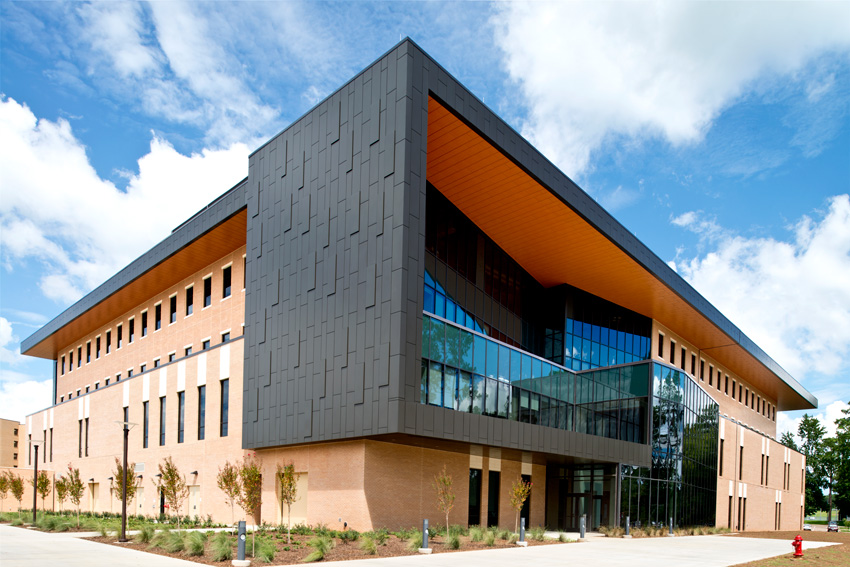
Photo courtesy Dri-Design, Inc.
The University of Texas at Tyler’s College of Business and Technology features a single-skin metal exterior. Understanding what specifications mean and how products are tested ensures a best fit for materials.
TESTING TO CERTIFY FORM AND FUNCTION
Product testing offers design professionals a vital, independent standard against which to evaluate and judge products. For products under consideration as both an exterior wall and rainscreen, there is a relatively new testing standard developed by the American Architectural Manufacturers Association (AAMA). Two different tests were developed:
- AAMA 508-07 (originally 508-05): Voluntary Test Method and Specification for Pressure Equalized Rain Screen Wall Cladding Systems; and
- AAMA 509-09: Voluntary Test and Classification Method of Drained and Back-Ventilated Rain Screen Wall Cladding Systems.
Both test methods use a standard specimen size and configuration of an 8-foot by 8-foot square mockup, with at least one vertical and one horizontal joint between panels. Both test methods allow for testing with a generic air and water barrier (AWB): a clear, plastic sheet, such as Lexan, which allows for visual observation from the interior side of the specimen. Both test methods require purposely designed defects, such as holes, in the generic AWB, to simulate imperfections that will most likely occur in the field. Both allow for the option of additional structural testing when using the actual AWB intended for a given job or system design.
AAMA 509-09 is used for evaluation of drained and back-ventilated systems. There are four essential design requirements for drained and back-ventilated systems evaluation:
- Water entry through the entire wall system (penetrating the AWB) shall be prevented.
- The AWB shall be designed to provide the primary weather protection.
- The system shall be designed to manage and drain any water entering the cavity behind the cladding and sufficiently vented to allow the cavity to dry.
- If water vapor diffuses from the building interior through the AWB and into the drained and back-ventilated system cavity, it shall be permitted to be vented and/or drained out to the exterior.
AAMA 509-09 pass/fail criteria is direct. The key criteria for the AAMA 509-09 test is that water penetration is not allowed through the entire wall system. Water is expected to hit the AWB.
Formerly AAMA 508-05, AAMA 508-07: Voluntary Test Method and Specification for Pressure Equalized Rain Screen Wall Cladding Systems is used to evaluate pressure-equalized rain screen systems. There are four essential design requirements for pressure equalized systems:
- Water entry through the entire wall shall be prevented.
- If water vapor diffuses through the interior wall construction (from the inside out), it shall be vented to the exterior.
- The actual AWB (when tested) shall be designed to resist the full positive and negative wind load.
- The system shall be designed such that it does not trap or hold concealed water and is able to control rainwater.
AAMA 508-07 pass/fail criteria is more definite than the criteria of 509-09. Failure is defined as either water mist or droplets appearing in excess of 5 percent of the AWB surface and/or water running in a continuous stream down the AWB surface. Additionally, the assembly is also tested to determine if it behaves as a pressure-equalized system, based on the lag time between the cyclic wind pressure and the cavity pressure, which is not to exceed 0.08 seconds. Finally, the maximum differential between the cyclic wind pressure and the cavity pressure, per AAMA, shall not exceed 50 percent of the maximum pressure when tested at 25 psf for 100 cycles.
A little definition behind the numbers used in the tests helps to clarify how the test numbers translate into real-world conditions. The test numbers are a base line. The unit of 6.24 pounds/square foot simulates about a 50-mph wind; 15 pounds/square foot is roughly equal to an 80-mph wind.
Depending on building requirements, additional testing for air, water, structural, and hurricane may be necessary. For exterior assemblies, the most commonly applicable additional tests include:
- ASTM E 283: Air Leakage;
- ASTM E 1233: Pressure Loading;
- ASTM E 331: Water Penetration;
- ASTM E 330: Structural Performance;
- AAMA 501.1: Dynamic Water; and
- Miami-Dade Hurricane Approval: High Velocity Hurricane Zone (HVHZ): Comply with ASTM E8/E8M test methods and performance requirements of Florida Building Code and Miami-Dade County test protocols TAS-202 and TAS-203 for HVHZ with at least plus 61 psf to minus 80 psf design pressure rating.
Translating Testing Results for the Best Product Decisions
While testing offers an invaluable source of third-party, independent information, it is still important to understand the ‘what’ and the ‘how’ behind each test and the results presented by manufacturers. Multiple products may earn a passing grade; how those systems were designed for the test is just as vital to understand. Independent testing agencies will test a product in any manner the manufacturer presents it to them, regardless of the standard details for a system. However, the testing agencies are required to report everything included in the assembly in the test documents. This means the specifier should ask to review the actual testing documents when comparing products. Design professionals and specifiers must be alert to details like hidden butyl tapes or sealants that may be used during testing but are not in the manufacturer’s standard details. Items that are absent from the manufacturer’s standard details but were present in testing increases the likelihood that components used in testing will fail to make it into project details, leading to performance issues.
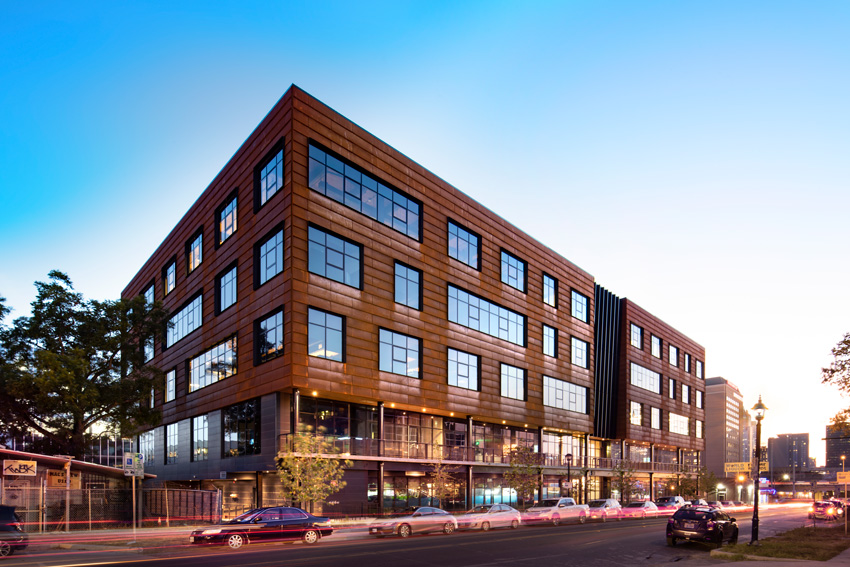
Photo courtesy Dri-Design, Inc.
As fire has become a bigger concern for today’s buildings, new fire codes and standards are being strictly enforced in more and more areas, including the 901 East Sixth Street project in Austin, Texas.
A Special Note on Combustibility
Fire has become a bigger concern for today’s buildings. New fire codes and standards are being strictly enforced in more and more areas.
Virtually every building, process, service, design, and installation is affected by the National Fire Protection Association’s (NFPA’s) codes and standards. NFPA standards reflect changing industry needs and evolving technologies, supported by research and development, and practical experience.
For exterior assemblies, like metal panels, NFPA 285: Standard Fire Test Method for Evaluation of Fire Propagation Characteristics of Exterior Wall Assemblies Containing Combustible Components is the governing regulation. This standard provides a test method for determining the fire propagation characteristics of exterior wall assemblies and panels used as components of curtain-wall assemblies that are constructed using combustible materials or that incorporate combustible components.
NFPA 285 is used to evaluate the fire propagation characteristics of exterior wall assemblies and panels used as components of curtain-wall assemblies, as specified in the following: first, the ability of the wall assembly to resist flame propagation over the exterior face of the wall assembly; second, the ability of the wall assembly to resist vertical flame propagation within the combustible components from one story to the next; third, the ability of the wall assembly to resist vertical flame propagation over the interior surface of the wall assembly from one story to the next; and fourth, the ability of the wall assembly to resist lateral flame propagation from the compartment of fire origin to adjacent compartments or spaces.
Meeting Codes with Single-Skin Metal Panels
Single-skin metal panels offer distinct advantages for buildings looking to satisfy multiple code requirements. Single-skin metal panels are carefully manufactured, created without ACM, MCM, or any composite materials. This makes the panels noncombustible, unlike plastic-cored products, and NFPA 285 compliant. Certain manufacturers’ single-skin metal panels are fully tested to exceed ASTM standards and the latest AAMA 508-07 for pressure-equalized rainscreens. The interlocking panel design makes installation quick and easy; it also means no hidden sealants or tapes are used to pass testing certification. Certain single-skin metal panels, such as panels with an aluminum plate thickness of 0.080 inch, satisfy the test methods and performance requirements of Florida Building Code and Miami-Dade County test protocols.
DIGGING DEEPER: THE ENVIRONMENTAL PROFILE OF SINGLE-SKIN METAL PANELS
Single-skin metal panels provide both a natural and highly customizable solution for the design professional. With diverse aesthetics, design capabilities, and performance opportunities, they bolster a building’s performance, visual appeal, and life cycle. Yet having both form and function falls slightly short of the high bar set for modern materials. The best material must also be sustainable and environmentally appropriate.
Single-skin metal panels answer the need for sustainability—naturally. Metal is a 100 percent natural and recyclable product. Often, panels are manufactured from recycled and repurposed metal. Panels are produced quickly with highly automated equipment, avoiding unnecessary energy costs. No plastic is involved in the production of single-skin metal panels, saving dramatically on fossil fuels.
Leading manufacturers produce panels domestically and purchase metal from domestic mills, which saves transportation energy costs. Certain single-skin metal panel systems use no silicone sealants, joint sealants, or gaskets, which are made with petroleum. This offers further savings of fossil fuels and on future maintenance costs. Certain manufacturers offer finish systems that produce no VOCs. Kynar paint providers are environmentally conscious finishers. They use a 100 percent air capture system and destroy the VOCs with a regenerative thermal oxidizer so there is no adverse environmental impact.

Photo courtesy Dri-Design, Inc.
The Wellness & Aquatic Center at Southwestern College in Chula Vista, California, features a dramatic application of single-skin metal panels incorporating various colors and image technology.
WHERE FORM AND FUNCTION MEET: SINGLE-SKIN METAL PANELS
Today’s innovations in single-skin panels are designed to overcome shortfalls in older methods of exterior metal panel systems, including delamination, staining due to the effects of weather on joint sealants and gaskets, rising costs of production, inefficient installation practices, and a general lack of color, texture, and design options.
Using a natural material with simple design and having new objectives about the way a system could perform, both at the time of installation and for decades later, gave birth to leading single-skin metal panel technology. That vision results in a material fully meeting both form and functional requirements: a highly customizable, 100 percent recyclable, pressure-equalized rainscreen, architectural metal wall system that attaches to nearly any substrate without the use of clips or extrusions, manufactured efficiently and designed to install faster than any comparable product, saving time and money. Leading single-skin metal panels are designed to pass the most stringent air, water, and structural testing requirements in the industry, including the AAMA 508-07 test for pressure-equalized rainscreens as well as Miami-Dade County hurricane testing.
Amanda Voss, MPP, is an author, editor, and policy analyst writing for multiple industry publications and teaching live continuing education courses.


